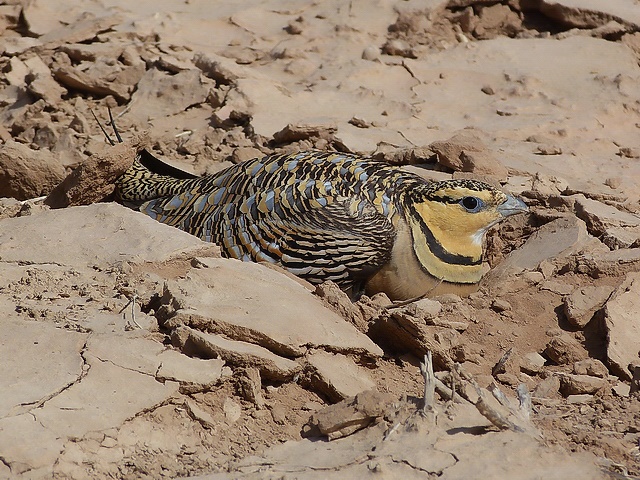Syrian Xeric Grasslands and Shrublands
The ecoregion’s land area is provided in units of 1,000 hectares. The conservation target is the Global Safety Net (GSN1) area for the given ecoregion. The protection level indicates the percentage of the GSN goal that is currently protected on a scale of 0-10. N/A means data is not available at this time.
Bioregion: Red Sea, Arabian Deserts & Salt Marshes (PA26)
Realm: Southern Eurasia
Ecoregion Size (1000 ha):
13,825
Ecoregion ID:
739
Conservation Target:
9%
Protection Level:
1
States: Syria, Iraq, Jordan, Turkey, Iran, Israel
Dry, dust-laden winds sweep through the searing landscape of Syrian Xeric Grasslands and Shrublands. Sparsely covered with grasses and scattered with dwarf shrubs, arid plains are navigated by striped hyena, marbled polecat, and Indian-crested porcupine. The Euphrates and Tigris Rivers forge a verdant path through otherwise hostile lands, and vital wetlands and fertile soils occur at their fringes; these are two of the most important waterways in Western Asia. This contrasting blend of dry grassland and riverine marshes is a paradise for the pin-tailed sandgrouse, a large bird with feathers of beautiful olive and chestnut hues.

The flagship species of the Syrian Xeric Grasslands and Shrublands ecoregion is the pin-tailed sandgrouse. Image credit: Creative Commons
The Syrian Xeric Grasslands and Shrublands ecoregion arcs across West Jordan, much of central Syrian Arab Republic, Northern Iraq, and a small area of Southwest Turkey. There is a strongly seasonal Mediterranean climate, with cool, wet winters and hot, dry summers. During the growing season, the effects of high temperatures are aggravated by dry winds, or sirocco, which makes the environment exceedingly hostile. Only low shrubs and grass can develop amidst such conditions.
Bulbous bluegrass, white wormwood, thorny saltwort, and Anabasis syriaca dominate, admixed with Carex stenophylla, Persian buttercup, and pockets of giant fennel and Ziziphus lotus. Two major rivers flow through this region, flanked by marshlands. The Tigris traverses Northern Iraq, whilst the Euphrates, the longest river in Western Asia, winds its way through Northeastern Syrian Arab Republic.
Endemic species have extremely restricted known distributions in this ecoregion. Tsolov’s mouse-like hamster has only been recorded from the Derra district in the Syrian Arab Republic, whilst Ananjva’s fan-fingered gecko and Jordanian fringe-fingered lizard are both known only from single localities in Jordan. Eastern olivaceous warbler and laughing dove are characteristic shrubland birds, whilst mammals include jungle cat, Libyan jird, long-eared hedgehog, and very small numbers of Arabian sand gazelle. Pin-tailed sandgrouse flock to waterholes at dawn; this region is home to a Middle-Eastern subspecies of the sandgrouse, which are threatened by loss of habitat to agricultural conversion.
Human use of this landscape has transformed over the past century. Traditionally, these grasslands were used for seasonal grazing by migratory Bedouin herders, with a few settled farmers along rivers growing winter grains. Today, land adjacent to major rivers is intensively cultivated, aided by mechanization and irrigation to support the growth of both grain in winter and cash crops such as cotton in summer.
Additionally, livestock numbers have dramatically increased, following the implementation of supplementary feeding to counter fatal droughts in 1961. The increase in sheep has resulted in a heightened grazing pressure on the landscape, and today livestock are raised using a combination of free-range grazing and supplementary feeding. Unpalatable shrubs are widely harvested for fuel, such as Anabasis syriaca and thorny saltwort. This region is also hugely important for the Syrian oil and gas industries. Protected areas are lacking, represented only by the Mujib Nature Reserve in Jordan.
Extensive grazing and cultivation have led to the disappearance of much of the natural vegetation, with detailed studies showing that habitat is severely degraded. Overgrazing is a pertinent issue, causing soil erosion and a shift towards dominance of unpalatable species in grasslands. Water resource depletion is a further threat that is particularly concerning in light of the high frequency of droughts, and increasing desertification jeopardizes native wildlife populations.
Furthermore, recent conflict across the region meant that little attention has been given to environmental issues. Nonetheless, conservation actions in the Syrian Arab Republic include establishment of pastoral and environmental reserves, control of desertification, and provision of forage alternatives to livestock to combat overgrazing. An emphasis has been placed on ensuring community participation with Bedouins, who have been involved in the formulation of management plans and trained with ecotourism-based skills, such as nature guiding and English literacy. In Iraq, the restoration of habitats from desertified shrubland is a priority.
The priority conservation actions for the next decade will be to: 1) ensure restoration focuses on natural ecosystem biodiversity and not just rehabilitation of key fodder species; 2) invest in continuous resource inventory and monitoring, particularly where extended droughts may have a significant impact on communities; and 3) enforce a sustainable grazing scheme for all users of the rangelands.
Citations
1. Louhaichi, M. and Tastad, A., 2010. The Syrian steppe: past trends, current status, and future priorities. Rangelands, 32(2), pp.2-7.
2. Hole, F. and Smith, R., 2012. Arid land agriculture in Northeastern Syria. In Land Change Science (pp. 209-222). Springer, Dordrecht.
3. FAO. Initiating a Response to the Degradation of Al Badia. [Online]. [Accessed 16th August 2019]. Available from: http://www.fao.org/3/Y5097E/y5097e05.htm

.png?auto=compress%2Cformat&w=300)

